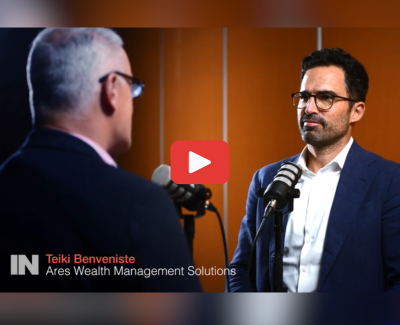Video: Deep-dive into the Ares Diversified Credit Fund
You should read the Fund’s Target Market Determination (TMD) and the Fund’s Product Disclosure Statement (PDS) to ensure the key attributes of the Fund as described in the TMD and PDS aligns with your objectives, financial situation and needs. These documents are available on the Apply Now page on this website.
Introducing the Ares Diversified Credit Fund
Matthew Holberton, National Manager of Capital Markets at Fidante Partners speaks to Head of Ares Australia Management, Teiki Benveniste on opportunities in credit markets and to tell us more about the Ares Diversified Credit Fund*.
For investors searching for dependable sources of high current income, without compromising on downside protection^ or diversification, we believe the Ares Diversified Credit Fund offers an attractive proposition for investors.
The Ares Diversified Credit Fund combines Ares’ credit capabilities: Liquid Credit, Alternative Credit and Direct Lending, and together, we believe these three credit asset classes can lead to consistent excess yield for our investors.
The Fund is available via Ares’ distribution partner Fidante Partners and is available to wholesale investors only. The Fund offers:
- Daily Application;
- Monthly Income; and
- Quarterly Redemptions (at Net Asset Value)
Endnotes
* The Fund gains its investment exposure by investing in the I Share Class of the CION Ares Diversified Credit Fund (Underlying Fund or CADC), cash and foreign currency exchange hedging instruments. Where we refer to the Fund’s investments we generally do so on a ‘look through’ basis; that is, we are referring to the underlying assets that the Fund is exposed to through its investment in the Underlying Fund. Underlying Fund inception: June 2017.
^References to “downside protection” or similar language are not guarantees against loss of investment capital or value. Diversification does not assure profit or protect against market loss.
Yield Premium
For illustrative purposes only. *Underlying Fund: CION Ares Diversified Credit Fund (CADC). Underlying Fund Data as of March 31, 2021. Portfolio yields are representative of a gross portfolio at each data point in time and do not represent returns to investors. Leveraged Loans represented by the Credit Suisse Leveraged Loan Index (“CSLLI”) current yield. High Yield Bonds are represented as the ICE BofA High Yield Master II Index (H0A0) current yield. European Loan Yields represented by the Credit Suisse Western European Leveraged Loan Index (WELLI). Please refer to additional important information related to indices.
Downside Protection Chart – History of Low Default & Loss Rates
For illustrative purposes only. As of March 31, 2021, unless otherwise noted. U.S. Direct Lending data as of December 31, 2020. PF = Pro Forma. Past performance is not indicative of future results. References to downside protection are not guarantees against loss of investment capital or value. Loan Default Rates are represented by the Credit Suisse Leveraged Loan Index (“CSLLI”). High Yield Market Default Rates are represented by the ICE BofA High Yield Index (H0A0). Please refer to additional important information related to indices.
- The default rates shown are pro forma which have been compiled by Ares. Pro forma results have inherent limitations, and no representation is being made that any account will or is likely to achieve profits or losses similar to those shown. Includes all first lien investments of the Credit Group’s U.S. direct lending team (excluding venture investments, oil & gas investments, private asset-backed securities, investments warehoused or held for seasoning or syndication purposes (including investments held for less than 30 days and other investments determined to be temporarily held by Ares in conjunction with syndication processes), and investments inherited from portfolio acquisitions), including investments made through Ares Capital Corporation (NASDAQ: ARCC) and from separately managed accounts and other funds. Loss rate represents the annualised defaulted invested capital as a percentage of total invested capital since inception. Default defined as total gains/(losses)on assets with a payment default as a % of total invested capital since inception, divided by number of years since inception. For realised investments includes interest, fees, principal proceeds, and related expenses. For unrealised investments, this number includes interest, principal proceeds, fees and related expenses received to-date, as well as the fair market value of the security as determined by the Manager in accordance with U.S. generally accepted accounting principles.
- The default rates shown are pro forma which have been compiled by Ares. Pro forma results have inherent limitations, and no representation is being made that any account will or is likely to achieve profits or losses similar to those shown. Includes all second lien, mezzanine, and other private high yield debt investments of the Credit Group’s U.S. direct lending team (excluding warrants and investments held for less than 30 days and investments inherited from portfolio acquisitions), including more than 90% from Ares Capital Corporation (NASDAQ: ARCC) and the remaining from separately managed accounts and other funds. Loss rate represents the annualised defaulted invested capital as a percentage of total invested capital since inception. Default defined as total gains/(losses)on assets with a payment default as a % of total invested capital since inception, divided by number of years since inception. For realised investments includes interest, fees, principal proceeds, and related expenses.
- Ares, LCD, Moody’s. U.S. Loan Market default rates represented by the default rate for the Credit Suisse Leveraged Loan Index. Ares default rates calculated as the weighted average of annual default rates since inception of the Ares bank loan strategy, measured January 2009 through March 2021.
- U.S. high yield bond market default rates represented by the ICE BofA High Yield Bond Index par default rate. Ares default rates calculated as the average of annual default rates since inception of the Ares high yield bond strategy, measured January 2009 through March 2021.
- EDL gross loss rate is calculated as the annualised realised losses of all realised investments made by the Ares European Direct Lending Team in its commingled middle market direct lending funds (ACE I, ACE II, ACE III and ACE IV) since inception in July 2007, including all Separately Managed Accounts (“SMAs”) managed within the European Direct Lending strategy and includes the Ares portion of the ESSLP, a joint venture between Ares and GE Commercial Bank SAS (“GECFB”), which was in operation between 2012-18 and is now fully realised. Realised losses are defined as amounts written off resulting from “debt for equity” restructurings and/or charge offs. As of March 31, 2021.
- The Illiquid Alternative Credit Subset reflects all opportunistic Alternative Credit investments. Please refer to slide 49 for additional information.
- As represented by the Ares Commercial Real Estate Corporation (“ACRE”) since inception, ACRE has originated $6.2 billion of real estate debt without a realised credit loss. As of March 31, 2021.
Ares’ Direct Origination Focus
For illustrative purposes only. Ares Underwriting Role calculated based on the cost basis of Ares U.S. Direct Lending’s portfolio as of December 31, 2020, excluding equity-only investments and legacy investments from portfolio acquisitions. Illustrative Direct Lending Economics based on data of the Underlying Fund Direct Lending portfolio as of March 31, 2021. Upfront fees and coupon are for deals allocated to the fund during the last twelve months. These figures reflect the yield assuming the full coupon amount is repaid and there is no loss of principal. The borrowers for these loans are generally not rated by any rating agency, and, if they were, they would likely receive a rating of below investment grade. The risk of loss of principal and/or failure of the borrower to make interest payments is substantial and, if this is were to occur, you would suffer losses that would reduce the return of the investment and would result in the loss of some or all of the invested capital.
Active Management Is Essential
For illustrative purposes only. Note: As of May 12, 2021. Represents opinions of Ares’ investment professionals only and should not be construed as investment advice. Dislocation defined as periods when high yield OAS increased above ~700 before returning to historical median of ~500. Source: The BofA US High Yield Master II Constrained Index (“HUC0”) OAS from January 1, 2000 through May 12, 2021. Please refer to additional important information related to indices.
Dynamic Allocation
For illustrative purposes only. Note: Percentages of portfolio allocation based on market value and excludes cash. As of May 31, 2021. Any investment involves significant risk, including the loss of principal.
Important Index Information
Note: Indices are provided for illustrative purposes only and not indicative of any investment. They have not been selected to represent appropriate benchmarks or targets for the strategy. Rather, the indices shown are provided solely to illustrate the performance of well known and widely recognised indices. Any comparisons herein of the investment performance of a strategy to an index are qualified as follows: (i) the volatility of such index will likely be materially different from that of the strategy; (ii) such index will, in many cases, employ different investment guidelines and criteria than the strategy and, therefore, holdings in such strategy will differ significantly from holdings of the securities that comprise such index and such strategy may invest in different asset classes altogether from the illustrative index, which may materially impact the performance of the strategy relative to the index; and (iii) the performance of such index is disclosed solely to allow for comparison on the referenced strategy’s performance to that of a well known index. Comparisons to indices have limitations because indices have risk profiles, volatility, asset composition and other material characteristics that will differ from the strategy. The indices do not reflect the deduction of fees or expenses. You cannot invest directly in an index. No representation is being made as to the risk profile of any benchmark or index relative to the risk profile of the strategy presented herein. There can be no assurance that the future performance of any specific investment, investment strategy, or product will be profitable, equal any corresponding indicated historical performance , or be suitable for a portfolio. The information related to the various indices is sourced from the providers’ websites. Ares is not responsible for any historic revision made to the indices. The indices include the reinvestment of dividends, interest and other earnings and have not been adjusted for management fees or expenses. Correlation results have been calculated using the monthly returns of the below reference indices:
- “U.S. Equities” is represented by the S&P 500 index. The S&P 500 index is designed to be a leading indicator of U.S. equities and is meant to reflect the risk/return characteristics of the large cap universe.
- “Global Equities is represented by the MSCI World Index. The MSCI World Index captures large and mid-cap representation across 23 Developed Markets (DM) countries. With 1,649 constituents, the index covers approximately 85% of the free float‐adjusted market capitalisation in each country. DM countries include: Australia, Austria, Belgium, Canada, Denmark, Finland, France, Germany, Hong Kong, Ireland, Israel, Italy, Japan, Netherlands, New Zealand, Norway, Portugal, Singapore, Spain, Sweden, Switzerland, the UK and the US.
- “U.S. High Yield” is represented by the ICE BofA High Yield Index (“H0A0”). The H0A0 consists of below investment grade U.S. dollar denominated corporate bonds that are publicly issued in the US domestic and yankee bonds (issues included in the index have maturities of one year or more and have a credit rating lower than BBB‐/Baa3, but are not in default).
- “U.S. Leveraged Loans” is represented by the Credit Suisse Leveraged Loan Index (“CSLLI”). The CSLLI is an index designed to mirror the investable universe of the $US‐denominated leveraged loan market.
- “European High Yield” is represented by the ICE BofA European High Yield Index (“HE00”). The HE00 ) tracks the performance of EUR denominated below investment grade corporate debt publicly issued in the euro domestic or eurobond markets.
- “European Leveraged Loans” is represented by the Western European Leveraged Loan Index (“WELLI”). The WELLI is designed to mirror the investible universe of the Western European leveraged loan market, with loans denominated in $US and Western European currencies.
- “US IG Corporate Debt” is represented by the ICE BofA US Corporate Master Index (“C0A0”). The C0A0 tracks the performance of US dollar denominated investment grade rated corporate debt publically issued in the US domestic market. To qualify for inclusion in the index, securities must have an investment grade rating (based on an average of Moody’s, S&P, and Fitch) and an investment grade rated country of risk (based on an average of Moody’s, S&P, and Fitch foreign currency long term sovereign debt ratings). Each security must have greater than 1 year of remaining maturity, a fixed coupon schedule, and a minimum amount outstanding of $250 million.
- “U.S. Fixed Income” is represented by Bloomberg Barclays U.S. Aggregate Bond Index. The Barclays Capital U.S. Aggregate Bond Index measures the performance of the U.S. investment grade bond market. The index invests in a wide spectrum of public, investment-grade, taxable, fixed income securities in the United States – including government, corporate, and international dollar-denominated bonds, as well as mortgage-backed and asset-backed securities, all with maturities of more than 1 year. To be included in the index, bonds must be rated investment grade (at least Baa3/BBB) by Moody’s and S&P. Inception date: January 1, 1976.
- “Asset-Backed Securities” is represented by the Bloomberg Barclays Asset-Backed Securities Index. The Bloomberg Barclays Asset‐Backed Securities Index is the ABS component of the Bloomberg Barclays U.S. Aggregate Bond Index and has three subsectors (credit and charge cards, autos, and utility).
- “Direct Lending” is represented by the NAV returns of Ares Capital Corporation (“ARCC”). Direct Lending is shown for illustrative purposes only and represents the change in net asset value (NAV) plus the value of dividends paid by Ares Capital Corporation (ARCC), a publicly traded business development company (BDC). ARCC invests primarily in directly originated debt; however, it also invests in some equity and other asset classes. ARCC performance is shown as representative of Ares’ track record in direct lending, as ARCC is Ares’ only direct lending fund that has been investing for over ten years. ARCC NAV and dividends are calculated on a quarterly basis, so for non-quarter end months, we assume 0% returns in order to create a monthly time series. As ARCC is a publicly traded BDC with the ability to invest in asset classes other than direct lending, its returns may be materially different than what an investor may achieve in a private fund invested solely in direct lending assets. In addition, ARCC NAV is calculated based on the fair value of ARCCs investments. Due to the illiquid nature of direct lending assets, the ability to liquidate them at their fair value cannot be assured.


